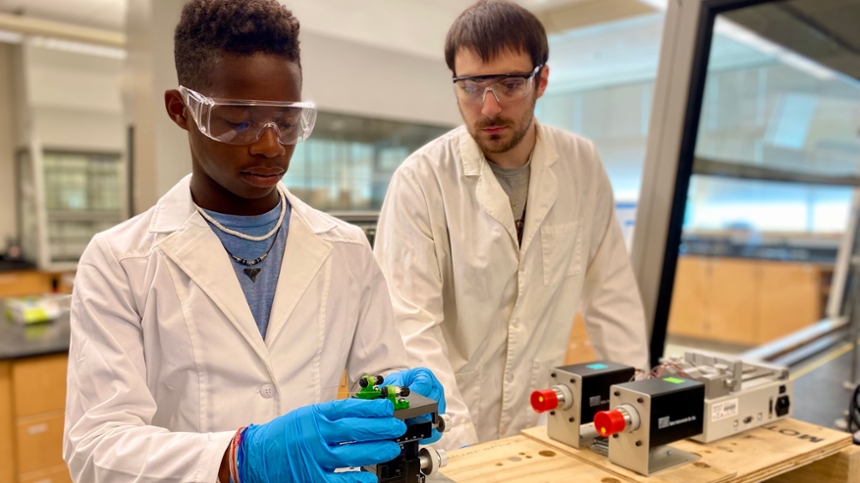Local High School Student Aids in Constructing New Measurement Tools at Rowan
Local High School Student Aids in Constructing New Measurement Tools at Rowan
Local High School Student Aids in Constructing New Measurement Tools at Rowan
September 21, 2022
 High school student, Matthew Will (left), works in the research lab with Rowan graduate student, Christopher Piccolo.
High school student, Matthew Will (left), works in the research lab with Rowan graduate student, Christopher Piccolo.
While many high school students from southern New Jersey headed to the beach, Matthew Will, a student at Moorestown Friends School, spent his summer break helping develop a new chemical measurement tool.
In June 2021, Associate Professor James Grinias in Rowan University's Department of Chemistry & Biochemistry received a message from Will asking about future career opportunities in the sciences and engineering. Impressed by his motivation, Grinias invited Will to spend a couple of days in his research laboratory. Will spent the time shadowing students involved in chromatography research and learning about what life is like as a scientist. After the experience, Grinias extended the high school student an open invitation to return and visit the lab. Little did either of them know that a much bigger opportunity would arise in 2022.
“I receive a lot of email messages from the National Science Foundation,” Grinias says, “but one that mentioned research fellowships caught my eye because I thought it might be a good opportunity to help financially support some of my research students at Rowan.”
The National Science Foundation’s (NSF) new MPS-High program focuses on broadening the participation of high school students in mathematics and physical sciences. Knowing it would be an excellent opportunity for a local high school student, Professor Grinias contacted Will to see if he would be interested in working in the lab over the summer. The project involved building instruments to analyze complex chemical mixtures as part of Grinias’ NSF-funded CAREER project. “I was really excited when I found out about this opportunity at Rowan,” remembered Will.
“I knew that Matthew wanted to work on something that combined aspects of chemistry and engineering, which are both crucial parts of our project,” Grinias said. After devising a suitable project to support his ongoing work supported by the Chemical Measurement and Imaging (CMI) Program at NSF, Grinias teamed Will with Rowan graduate student Christopher Piccolo. Together they worked on designing a stage that could connect to a home-built chromatography system with a mass spectrometer.
“I got to learn about computer-aided design and 3D printing this summer, which are both big parts of developing new technology,” said Will.For Piccolo, getting an opportunity to mentor a young scientist was his favorite part of the project. “Matthew didn't have a lot of background knowledge on computer modeling when we started, and after just a couple of months, he is now able to take a simple idea and turn it into a complete physical object in the same day,” he said.
The team is planning on presenting their work at the Eastern Analytical Symposium in Princeton, New Jersey, this November. “I don't know too many high school students that get to present scientific research at EAS,” Grinias says, “but Matthew’s work is helping advance the field of capillary liquid chromatography and it will be great for him to share it with other analytical chemists in the area.”